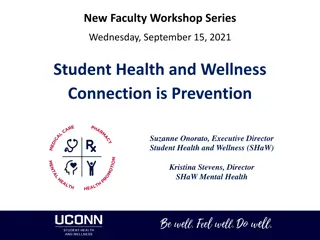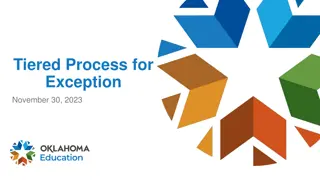Effective Strategies for Multi-Tiered Student Support Systems
Efficient multi-tiered student support systems are crucial for addressing students' needs effectively. Combining accurate early warning indicators with appropriate supports helps in early intervention and successful outcomes. The ABCs of secondary school success highlight key indicators to monitor, while emphasizing the importance of building strong student-adult relationships. These systems require ready access to indicators, data analysis, and organized responses tailored to student needs across different tiers of support.
Download Presentation

Please find below an Image/Link to download the presentation.
The content on the website is provided AS IS for your information and personal use only. It may not be sold, licensed, or shared on other websites without obtaining consent from the author. Download presentation by click this link. If you encounter any issues during the download, it is possible that the publisher has removed the file from their server.
E N D
Presentation Transcript
Building a Multi-Tiered Student Support System The Middle School Matters Fall Summit Robert Balfanz and Ben Reyes October, 2014
GOOD EARLY WARNING SYSTEMS COMBINE ACCURATE AND USEFUL INDICATORS WITH EFFECTIVE MULTI-TIERED STUDENT SUPPORTS
ABCs of Secondary School Success On Path to Dropping Out On Path to College Ready Early Indicator Miss 20 or more days- 10% Attendance Miss 5 or Fewer Have Self-Management, Regulation, and Advocacy Skills High on Hope Multiple Suspensions Sustained Mild Misbehavior Behavior F s and D s (Failure often driven by not completing/turning in assignments) Course Performance B average
Why We Need Multi-Tiered Student Support Systems Effective interventions are essential, but we can not intervene our way to a stronger system. Once a student has an off-track indicator you either need to solve a problem or change a behavior. This requires a strong relationship between an adult and the student. If there are more students in need than adults to form strong relationships, you are in trouble.
WHAT DO WE KNOW ABOUT MULTI-TIERED STUDENT SUPPORT SYSTEMS
Effective Student Support Systems Combine: Ready access, at the classroom level, to on- and off- track indicators (the ABCs); Regular time to analyze the data, pool adult knowledge about students, and leverage existing adult-teacher relationships; and An organized response system that can act upon early warning data in both a systematic and tailored manner.
Effective Student Support Systems Combine: Tier 1 - evidence-based whole school/classroom prevention for the ABCs (attendance, behavior and effort, course performance) Tier 2 - targeted problem-solving and moderate intensity supports when prevention does not work Tier 3 - case managed high-intensity supports for the neediest students
Multi-Tiered Student Support System Intensive One on One Supports: Driven by needs assessment Case managed Professionally provided when whole school and moderate intensity supports are not sufficient Intensity of interventions Extra-Supports Provided: At first sign of student need To all students who need it (no triage) Diagnostic tools insure it s the right support (e.g. cognitive or socio-emotional) Moderate intensity but if needed continuously available Whole School is Organized and Supported to Enable: Effective instruction (including teacher professional development connected to the early warning indicators) Safe and positive learning climate High student engagement (Attend, Behave, Try Hard) Collective efficacy and all graduate mission among staff
Using a Multi-Tiered Student Support System Practice intervention discipline. Do not go first to the highest intensity intervention. Use knowledge of your school and students when choosing interventions (one size does not fit all). Assign adult champion with a relationship with student to make sure targeted or intensive intervention occurs. Track outcomes of interventions on a regular basis.
Multi-Tiered Student Supports More Advanced Work Have diagnostic tools to deduce if student behavior is driven by academic, socio-emotional needs or both. Look for and act upon patterns that emerge from the data what is the most effective and strategic level of intervention student, classroom, or school? Use additional data to tailor interventions Are most students failing overage? ELL? From just one or two classrooms?
Whole Group Activity Look at the Early Warning Indicator data at your table. What patterns do you see? What might be the most strategic level of intervention?
EFFECTIVE SCHOOL-WIDE AND TARGETED STUDENT SUPPORT ACTIONS
Focus on the ABCs - Attendance Schools and communities need to measure and act on chronic absenteeism the number of students who miss 10% or more of school (i.e. a month or more of school). They also need to measure those who miss a week or less. Organize comprehensive efforts base on fact that student absenteeism is driven by combination of factors, including student choice, avoiding in-school challenges, and out-of- school issues pulling them away.
Focus on ABCs - Attendance Create programming that compels students to come to school, e.g., most-engaged secondary students often found in cognitively rich activities that combine teamwork with performance (robotics, debate, drama, chess etc.) Build an attendance problem-solving capacity into schools and districts. Extend this via relationships with wraparound service providers and organizations that can provide additional adults during the school day to serve as Success Mentors.
Some Simple Ideas That Have Worked Write a Plan-ask student to write with some detail what it would take to miss only 1 day of school next month. Keeping up with the Jones-show students the attendance records of students who have recently graduated and succeeded in college. What a day here and there can add up to-show students how many months/years of school they will miss if current attendance pattern continues.
More Simple Ideas That Have Worked Happy to see you today make sure that whenever a student returns from being absent someone says Happy to see you (without judgment or tone in their voice). Being in school helps others consistent recognition for collective improvement and reaching attendance goals. Follow the peer leader organize students to measure, monitor, and act.
An Important Mitigation Strategy It s the assignments to mitigate impact of Chronic Absenteeism need system that makes sure Chronically Absent students get their assignments done.
Poor Attendance Often Drives Course Failure Attendance is eight times (8x) more predictive of course failure than prior test scores. Source: Chicago Consortium of School Research
Focus on ABCs - Course Performance Provide course coaching, support, and on occasion, even advocacy, which enables students to succeed in their courses. This should include monitoring assignment completion, preparation for tests and quizzes, and helping students catch up when absent. Make sure tutoring efforts are linked tightly with needs and expectations of student s courses (don t work on fractions during a tutoring session on Thursday if Friday s test is on probability). Need effective second chance and credit recovery programs that hold students accountable but provide a reason for them to keep trying.
4 Diagnostic Questions About Students Who Are Failing Courses Are they regularly attending school? If not, why not? Are they able to focus on schoolwork in school? Are they productively persistent, i.e. trying in an effective manner? Do they connect school effort to life success?
Focus on ABCs - Behavior and Effort Model and teach resiliency and self-management and organization skills. Implement school-wide positive behavior support programs and alternatives to suspensions. Work to insure that students experience consistent academic and behavioral norms as they travel from class to hall and class again. Build Success Scripts in students heads (effort leads to success), work to undermine Failure Scripts (success is capricious, withholding effort keeps you psychologically safe).
A Deeper Strategy Build Up Hope and Purpose students need to have a reason to come everyday, try hard, and behave.
GALLUP ANNUALLY SURVEYS HUNDREDS OF THOUSANDS OF 5TH TO 12TH GRADE STUDENTS ABOUT THEIR HOPE, ENGAGEMENT, AND WELL-BEING. WHAT HAVE THEY FOUND?
Hope Hope involves taking positive thoughts about the future, putting lots of resources and hard work behind them, and gauging your progress until it happens. Hope drives attendance, credits earned, and GPA in high school. Hope varies by place not by grade. Those who feel the most hopeless are the lowest income male students in cities with high inequality and low social mobility. Students are generally confident in their future but lack necessary strategies to reach big goals of graduation and employment. 46% are not confident they can find many ways to get good grades.
Engagement Engagement varies by grade. It is high in elementary school and declines through the middle grades and early high school years. Decline directly linked to student s perceptions about the value placed on good schoolwork. 74% of 5thgraders said In the last 7 days I have received recognition or praise for doing good schoolwork. Compared to only 31% of 9th graders. Also sharp decline between 5th and 8thgrade in My teachers make me feel that my schoolwork is important. Students also report significant decline in how frequently teachers make them feel excited about the future.
Engagement Students who strongly agree that their school is committed to building their strengths and that they have a teacher who makes them excited about their future are almost 30 times as likely to be engaged learners as their peers who strongly disagree
Well Being 5th Grade 8th Grade 12th Grade Were you treated with respect all day yesterday? 75% 65% 68% Did you learn something interesting yesterday? 82% 73% 71% Did you have enough energy to get things done yesterday? 85% 75% 60%
Report Card Conferences The belief is that talking to a trusted but objective adult takes the emotion out of the process and helps students focus on what's really holding them back. Greg Toppo, USA TODAY 12/4/2006
Student Feedback I feel like I still have a chance now; when I came in I wanted to throw my report card away. I didn t know the word advocate before I met that lady, but I will speak up for myself now. Somebody actually cares about me. I hope I get to talk to him again next time.
Our Design Brief Pool our insights, knowledge and experiences to understand what school structures, strategies and adult efforts can create the conditions needed to develop productive persistence, hope, engagement, and well-being among adolescents who live in high-poverty environments and how this can be translated into better attendance, better behavior and effort, and better grades.
What Student Strengths Can we Build Upon? Take a minute to brainstorm with your table.
Take Away Challenge Use the three tiered grid and its questions about need, capacity, and effectiveness to evaluate and improve the multi-tiered student support system in your school/district.
For more information Visit the Everyone Graduates Center at www.every1graduates.org For this and additional PowerPoints presented during Middle School Matters, please visit www.every1graduates.org/bushinstitute2014




































